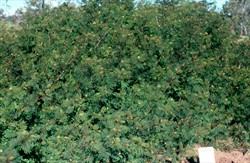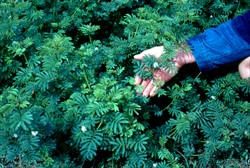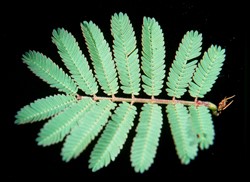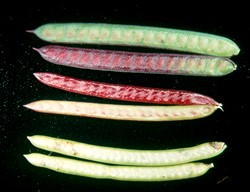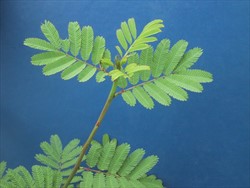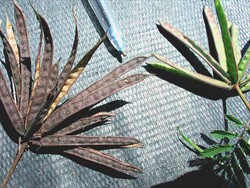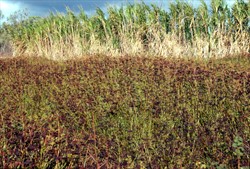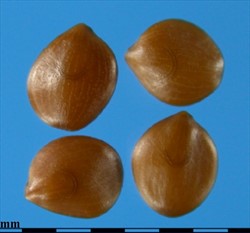Desmanthus pubescens
Tropical Forages
Desmanthus pubescens B.L. Turner
Note: Turner (1950) regarded Desmanthus virgatus as [1] [2] [3] an all-encompassing species, comprising D. virgatus [1] [2] [3], D. pubescens , D. pernambucanus , D. glandulosus and D. leptophyllus. Despite taxonomic revision by Luckow (1993) that resolved the complex to distinct species, many authors continued to refer to all species as D. virgatus [1] [2] [3] in the literature until the late 1990s. Correct nomenclature is now generally used.
None listed in GRIN
Family: Fabaceae (alt. Leguminosae) subfamily: Caesalpinioideae (mimosoid clade*) tribe: Mimoseae.
* Azani, N. et al. [97 authors from 54 institutions] 2017. A new subfamily classification of the Leguminosae based on a taxonomically comprehensive phylogeny. Taxon 66: 44–77.
Erect to spreading woody shrub to 1.5 m tall, strongly branching from the base. Young stems green and hairless, angular with golden corky ridges. Older stems hairless, shiny red or brown, with a waxy, shedding cuticle; sometimes developing adventitious roots where prostrate stems contact moist soil. Stipules persistent, 2.5‒7 mm long, setiform with erose, striately nerved auricles at the base. Leaves paribipinnate 2.5‒5.7 cm long, petiole 4‒10 mm long, rachis 10‒33 mm long, sparsely pubescent; pinnae 10‒30 mm long, 3‒7 pairs, with an orbicular to elliptic, sessile, crateriform, red nectary 0.6‒1.7 mm diameter inserted between the lowermost pair; pinnules 11‒22 pairs, 2.2‒5.0 mm long and 0.7‒1.1 mm wide. Capitulum (flower head) 0.7‒1.0 cm long, occur singly in leaf axils on peduncles 1.0‒4.5 cm long. Heads contain (8‒) 12‒20) flowers that may be perfect, functionally male or sterile; sterile flowers (2‒) 4‒6 at base of head; male flowers (0‒) 1‒6 towards base of head above sterile flowers, and below perfect flowers; perfect flowers (4‒) 8‒15, apical. Pods borne on fruiting peduncles 1.5‒4.2 cm long, each bearing 2‒11 pods; pods 3.7‒8.5 cm long and 3.2‒5.0 mm wide, linear or recurved; tip acute or more often apiculate with beak 1‒4 mm long; red or green when immature, densely white pubescent; reddish-brown to nearly black at maturity; tardily dehiscent along both sutures. Seeds 7‒22 per pod, 2.3‒3.2 × 1.8‒2.5 mm, flattened, ovate, reddish-brown or black. 186,000 seeds/kg in cv. Uman.
Latin America: guajillo (Oaxaca), guashillo (Puebla), chinchibe (Campeche), alta missa (Tabasco) (Mexico)
Native:
Northern America: Mexico (Campeche, Puebla, Quintana Roo, Tabasco, Veracruz, Yucatán)
Caribbean: Cuba (?)
Central America: Belize; Guatemala
Forage
D. pubescens is fed to horses in its native Tabasco, where it occurs in dense stands. There is little experience with this species in cultivation. However, the vigour, leafiness and form of the plant suggest it to have potential in grazed or cut-and-carry situations in areas where it is well-adapted, which may be areas of higher rainfall than where other species of Desmanthus have been evaluated.
Soil requirements
Occurs on a range of soil textures from sands to clays, sometimes gravelly or rocky, largely of calcareous origin. It has grown well on a range of soils in cultivation including some slightly acid soils, but may be most successful in soils of near neutral to alkaline pH with high levels of calcium on the exchange complex.
Moisture
In its native range, D. pubescens occurs in dense stands in swampy areas, but also in better drained areas along roadsides, in environments receiving an average annual rainfall of 1,000‒1,800 mm, with a moderate 4‒6 month dry season. Long-term persistence in semi-arid and sub-humid environments (500‒800 mm average annual rainfall) has been poor despite its ability to tolerate considerable dry periods.
Temperature
In its native lowland tropical environment, average annual temperature is of the order of 26 °C, with only minor monthly fluctuations. D. pubescens has proven reasonably cold tolerant when sown in the subtropics. While it is defoliated by heavy frosts, larger plants can regrow from crowns once there is sufficient heat and moisture for growth.
Light
Poor tolerance of medium to heavy shade.
Reproductive development
In the native range (16‒21° N), D. pubescens flowers from December to April and fruits from February to June. This short-day flowering response (i.e. late-flowering) in cv. Uman is sufficient to sometimes preclude seed-set in subtropical Australia due to frost. Consequently, there is little opportunity for seedling recruitment.
Defoliation
Tolerant of regular cutting and grazing by ruminants. Desmanthus spp. are among the most grazing tolerant of the forage legumes in sown pastures on clay soils in sub-humid, northern Australia. However, in a grazing trial (rotational cycle of 7-day grazing and 21-day rest) where sheep selectively grazed the legume over the companion Cynodon dactylon, all D. pubescens plants died while only 20% of the D. bicornutus plants in an adjacent treatment succumbed.
Fire
Regrows from the crown after moderate fire.
Guidelines for establishment and management of sown forages.
Establishment
As with all small seeded legumes, establishment on clay soils is unreliable. For most successful establishment sow scarified seed no deeper than 2.0–2.5 cm into moist soil, and preferably into a cultivated seedbed with good subsoil moisture. D. pubescens has larger seed than D. virgatus [1] [2] [3] and will tolerate slightly deeper planting depths. Surface broadcasting onto a well-prepared seedbed, followed by rolling has given good results. It has also been successfully planted into cultivated strips in established grass pastures, or sod-seeded into slashed pasture treated with glyphosate to suppress grass growth. Fresh seed is extremely hard-seeded and should be scarified, either abrasively (e.g. using a rice polisher) or by hot water treatment (4–10 seconds in boiling water), to raise the germination to a minimum of 50–70%. It is important to achieve good establishment from the plant crop, as seed produced from paddock plants remains hard-seeded for 2–3 years.
Cv. Uman can be propagated from stem cuttings.
Fertilizer
May respond to S, Mo, P, Cu and Mn on neutral to alkaline clay soils. A critical leaf tissue concentration of 0.2% S is required for optimum productivity. DM yield responses have been obtained in other Desmanthus spp. to applied P at 35‒50 kg/ha in P-deficient soils. Higher rates of P-fertilizer may decrease DM yields.
Compatibility (with other species)
Its deep-rooted habit enables it to be grown with stoloniferous and other competitive grasses. D. pubescens has formed productive mixtures in exotic, sown pastures as well as with useful native species. In northern Australia, plant crops of cv. Uman have persisted well in the short term in buffel grass (Cenchrus ciliaris) and other tropical grass forages. However, long-term persistence has been poor as initial plants senesce, and because seedling recruitment is low due impaired seed production in the late-flowering cultivar and the extreme hardseededness of any seed produced. Other accessions of D. pubescens studied were also late flowering. Controlled grazing during flowering and seed development may improve persistence.
Companion species
Grasses: Cenchrus ciliaris, Dichanthium sericeum, Panicum coloratum var. makarikariense.
Pests and diseases
Occasional, minor damage by psyllid insects (Accizia spp.) was reported in northern Australia. The psyllids cause more serious damage in seed crops. Several seed-eating bruchid beetles (5 Acanthoscelides spp. and 1 Stator sp.) are known to infest Desmanthus. No other reports of serious pests and diseases were cited.
Ability to spread
Being very late flowering and producing only limited seed under grazing, spread of cv. Uman in central and southern Queensland has been limited and in many instances it has not persisted. In northern (tropical) Queensland, cv. Uman produces abundant seed.
Weed potential
Has potential to become a weed of disturbed areas due to its potential for high seed production in the tropics, and erect, woody habit, but is not currently listed as a major weed.
Nutritive value
In sacco DMD and N concentration of 'Uman' (CPI 92803) of 70% and 2.3%, respectively have been measured. N%, P%, and ADF in the terminal 15 cm of 'Uman' have been measured at 4%, 0.2% and 16.5% for leaf, and at 2%, 0.2% and 35.6% in the stem fraction, respectively.
Palatability/acceptability
Palatability is rated as moderately palatable to grazing ruminants, lower than that of leucaena (Leucaena leucocephala) but higher than that of Stylosanthes scabra cv. Seca.
Toxicity
No toxicities to ruminant livestock have been reported. Desmanthus spp. do not cause bloat in ruminants because they contain 2–3% (of total DM as tannic acid equivalent) condensed tannins.
Dry matter
Generally more productive than D. virgatus [1] [2] [3] but less productive than D. leptopyllus in subhumid environments. An annual yield of up to 19 t/ha of DM was obtained in a warm subhumid environment at 24º N in Mexico, although over 50% of the dry matter was stem.
Animal production
In a pen feeding experiment where a Mitchell grass (Astrebla spp.) basal diet was supplemented with cv. Uman, DM intake of Merino wethers increased from 580 to 720 g/head/day, and wool growth increased from 0.48 to 0.65 g/day/cm². No grazing trials assessing animal liveweight gains from D. pubescens are reported in the literature.
Taxonomic confusion within the genus has led to a vast range of accessions from D. pernambucanus, D. leptophyllus, D. pubescens and D. virgatus [1] [2] [3] being evaluated as D. virgatus[1] [2] [3]. Genetic and phenotypic diversity in D. pubescens is limited, which restricts the development of new cultivars. Level of out-crossing is low. No breeding work has been undertaken with the species to date.
Seed yields of 400‒500 kg/ha are achieved from direct-headed crops, but considerable seed losses occur due to uneven ripening and early seed fall. The potential seed yield using a suction harvester is in excess of 1,000 kg/ha, however the suction required to collect the dense Desmanthus seed can result in large quantities of small stones in the sample.
Late-flowering types require an extended period of favourable moisture conditions to flower and set seed. A high proportion of under-developed, immature embryos that are non-viable or of low vigour can occur in late-flowering types grown in sub-tropical environments where frosting and moisture stress may occur during seed development. These seeds are of similar dimensions to fully mature seeds and are therefore very difficult to remove during conventional seed grading.
A psyllid insect (Accizia sp.) can cause severe damage to seed crops in Australia and may need to be controlled using insecticides.
Seed production is sensitive to phosphorus deficiency, and crop yields may be improved by application of up to 25 kg/ha P on low P soils.
Killed by Access® herbicide (120 g/L picloram and 240 g/L triclopyr).
- High rates of seed production in tropical frost-free regions.
- Tolerant of heavy grazing.
- Tolerant of alkaline, sodic, saline and heavy clay soils.
- Has potential as a phase legume in cropping systems.
- Poor regeneration from seed in sub-tropical environments.
- Becomes stemmy when ungrazed or lightly grazed.
- Specific in its rhizobium requirements (CB 3126).
Burt, R.L. (1993) Desmanthus: a tropical and subtropical forage legume. Part 1. General Review. Herbage Abstracts 63:401–413.
Burt, R.L. (2016) Searching for pasture legumes for heavy clay soils in Australian dry tropics and subtropics: IV. Evaluation in Western Queensland. In: Lazier, J.R. and Ahmad, N. (eds) Tropical forage legumes: Harnessing the potential of Desmanthus and other genera for heavy clay soils. CAB International, Wallingford, Oxon, UK. p. 204–253. doi.org/10.1079/9781780646282.0204
Clem, R.L. and Cook, B.G. (2004) Identification and development of forage species for long-term pasture leys for the southern speargrass region of Queensland. In: Whitbread, A.M. and Pengelly, B.C. (eds) Tropical legumes for sustainable farming systems in southern Africa and Australia. ACIAR Proceedings No. 115. Australian Centre for International Agricultural Research (ACIAR), Canberra, Australia. p. 64–79. aciar.gov.au/node/8436
Cox, K.G. and Harrington, K.C. (2005) Selective herbicide strategies for use in Australian Desmanthus seed crops. Tropical Grasslands 39:171–181. bit.ly/2WNQC7G
Gardiner C.P. and Burt R.L. (1995) Performance characteristics of Desmanthus virgatus in [1] [2] [3] two contrasting tropical environments. Tropical Grasslands 29:183–187. bit.ly/2QRiB2J
Gardiner, C.P. (2016) Developing and commercializing new pasture legumes for clay soils in the semi-arid rangelands of northern Australia. In: Lazier, J.R. and Ahmad, N. (eds) Tropical forage legumes: Harnessing the potential of Desmanthus and other genera for heavy clay soils. CAB International, Wallingford, Oxon, UK. p. 283–304. doi.org/10.1079/9781780646282.0283
Garza, R.D., Zárate, P., Saldivar, A.J., Ocumpaugh, W.R. and Hussey, M.A. (2003) Evaluation of management system on bundleflower Desmanthus pubescens B. Turner cv. Hussey "543". Proceedings of the American Forage and Grassland Council 12:323–326. bit.ly/2UGZv03
Garza R.D., Zárate P., Saldivar A.J., Ocumpaugh W.R. and Hussey M.A. (2004) Yield distribution in bundleflower (Desmanthus pubecens cv. Hussey) canopy as affected by harvest frequency. Proceedings of the American Forage and Grassland Council 13:379–383. bit.ly/2xtl5xd
Hopkinson, J.M. and English, B.H. (2004) Germination and hardseededness in Desmanthus. Tropical Grasslands 38:1–16. bit.ly/2wyIPA7
Jones, R.M. and Brandon, N.J. (1998) Persistence and productivity of eight accessions of Desmanthus virgatus under [1] [2] [3] a range of grazing pressures in subtropical Queensland. Tropical Grasslands 32:145–152. bit.ly/39luAvP
Jones, R.M., Bishop, H.G., Clem, R.L., Conway, M.J., Cook, B.G., Moore, K. and Pengelly, B.C. (2000) Measurements of nutritive value of a range of tropical legumes and their use in legume evaluation. Tropical Grasslands 34:78–90. bit.ly/2WMzAqx
Luckow, M. (1993) Monograph of Desmanthus (Leguminosae-Mimosoideae). Systematic Botany Monographs Vol. 38. American Society of Plant Taxonomists, Laramie, WY, USA. doi.org/10.2307/25027822
Pengelly, B.C. and Liu, C.J. (2001) Genetic relationships and variation in the tropical mimosoid legume Desmanthus assessed by random amplified polymorphic DNA. Genetic Resources and Crop Evolution 48:93–101. doi.org/10.1023/A:1011234913710
Spiers, P.R., Brandon, N.J., Date, R.A., Bahnisch, L.M. and George, D. (1998) Nutrient limitations of clay soils for Desmanthus virgatus. [1] [2] [3] II. A glasshouse study of 7 soils. Tropical Grasslands 32:6–12. bit.ly/2JjDL54
'Uman' (CPI 92803) Granted PBR protection in Queensland, Australia (1992). Origin Campeche, Mexico (18°09' N, 50 m asl, rainfall 1,250 mm). A very late-flowering cultivar (about 135 days), growing to a height of 40–100 cm. Best suited to the humid tropics. Seed of this cultivar is no longer commercially produced.
'Hussey' (CF 543, IRFL 2961, CPI 83584, CPI 92803 = 'Uman') Evaluated Tamaulipas, Mexico.
CPI 92801, CPI 92802, CPI 92804, CPI 92807, CPI 92811, CPI 92812, CPI 92813 Assessed in Australia. All similar to cv. Uman, originating from the same relatively small region around the southern Gulf of Mexico in the Districts of Corozal and Orange Walk in Belize, and States of Campeche and Quintana Roo in Mexico.
